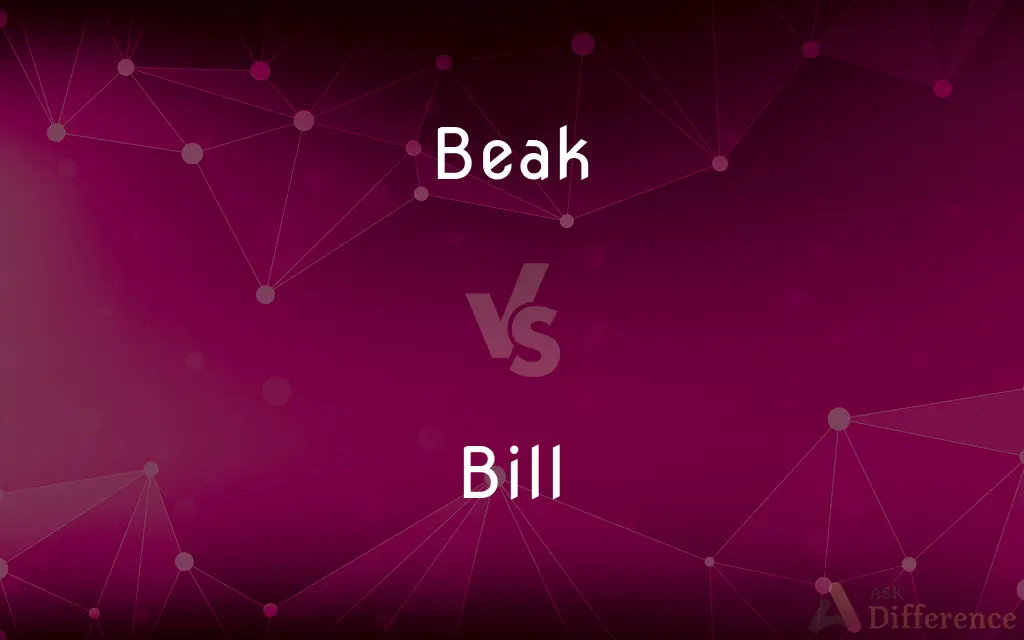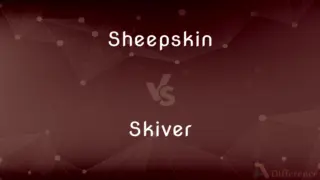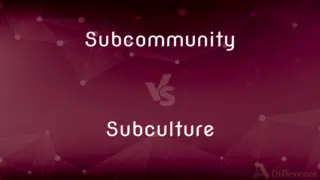Beak vs. Bill — What's the Difference?
By Tayyaba Rehman — Updated on September 25, 2023
Beak” primarily refers to the hard, pointed mouthpart of birds, while “Bill” can also refer to a bird’s mouthpart, often emphasizing its functionality, such as in waterfowl.

Difference Between Beak and Bill
Table of Contents
ADVERTISEMENT
Key Differences
A "Beak" is predominantly known as the hard, protruding mouthpart of birds, equipped with varying shapes and sizes to adapt to their diverse feeding habits and environments. It is commonly associated with birds of prey like eagles and hawks, where it is used as a potent tool for tearing prey. "Beak" conveys more of the physical aspect of the mouthpart, focusing on its structure and form, illustrating the adaptability and specialization of birds in their respective ecological niches.
In contrast, the term "Bill" is also used to describe the mouthparts of birds, but it is often applied to depict the functionality and utility of the mouthpart, especially in species like ducks and other waterfowl. "Bill" typically implies a broader and flatter form, emphasizing its use in activities like dabbling and filtering food from water. It is a term that, while synonymous with beak, often brings to the fore the interaction of the bird with its environment, focusing on the utility and functionality of the mouthpart.
While "Beak" tends to highlight the anatomical characteristics, structure, and adaptability of the mouthparts, "Bill" often sheds light on the diverse functionalities and interactions of this organ within the bird's habitat. This distinction in emphasis reflects the incredible diversity of avian species and their adaptative developments, allowing them to inhabit a plethora of environments and exploit various food sources. These two terms, while similar, encapsulate the structural and functional diversity of avian mouthparts, contributing to our understanding of avian biology and ecology.
Each word, "Beak" and "Bill," illustrates different aspects and nuances of avian mouthparts. Where "Beak" tends to represent the structural form and adaptative variations, "Bill" often reflects the functional adaptations and interactions with the environment. Understanding the subtle distinctions between these terms enhances the appreciation and study of the myriad avian species and their intricate adaptations, enriching the fields of ornithology and ecology.
In ornithology, the terms "Beak" and "Bill" are pivotal in studying and understanding the diverse adaptations and ecological roles of birds. They serve as lenses through which the intricate relationships between birds and their environments can be explored, offering insights into the evolution, behavior, and ecology of these feathered creatures.
ADVERTISEMENT
Comparison Chart
Focus
Emphasizes the structural and anatomical aspects.
Often emphasizes the functionality and utility.
Usage
Commonly associated with birds of prey.
Typically applied to waterfowl.
Representation
Represents the hard, pointed mouthpart of birds.
Implies a broader and flatter form.
Interaction
Illustrates adaptability and specialization.
Reflects interaction with the environment.
Synonymy
Is often used as a general term for a bird’s mouthpart.
Is synonymous but emphasizes different aspects.
Compare with Definitions
Beak
The hard, pointed mouthpart of birds.
The eagle used its sharp beak to tear into its prey.
Bill
The mouthpart of a bird emphasizing its functionality.
The duck uses its bill to filter food from the water.
Beak
A projection of a bird's jaw serving as a tool for feeding.
The bird's beak is well adapted to its feeding habits.
Bill
Often applied to describe the mouths of waterfowl.
The swan has a long and elegant bill, suited to its feeding habits.
Beak
A term emphasizing the structural aspects of a bird’s mouthpart.
The beak of the toucan is colorful and large in proportion to its body.
Bill
A term reflecting a bird’s interaction with its environment through its mouthpart.
The pelican's large bill is crucial for scooping up fish from the water.
Beak
The beak, bill, and/or rostrum is an external anatomical structure found mostly in birds, but also in non-avian dinosaurs and some mammals. A beak is used for eating and for preening, manipulating objects, killing prey, fighting, probing for food, courtship and feeding young.
Bill
Represents the broader, flatter form of a bird's mouthpart.
Birds like ducks and geese have bills adapted for dabbling and grazing.
Beak
A bird's horny projecting jaws; a bill
A parent bird with a caterpillar in its beak
Bill
An itemized list or statement of fees or charges.
Beak
A magistrate or a schoolmaster.
Bill
A statement or list of particulars, such as a theater program or menu.
Beak
The bill of a bird, especially one that is strong and curved, such as that of a hawk or a finch.
Bill
The entertainment offered by a theater.
Beak
A similar structure in other animals, such as turtles, insects, or fish.
Bill
A public notice, such as an advertising poster.
Beak
A usually firm, tapering tip on certain plant structures, such as some seeds and fruits.
Bill
A piece of legal paper money
A ten-dollar bill.
Beak
The spout of a pitcher.
Bill
(Slang) One hundred dollars.
Beak
A metal or metal-clad ram projecting from the bow of an ancient warship.
Bill
A bill of exchange.
Beak
(Informal)The human nose.
Bill
(Obsolete) A promissory note.
Beak
A schoolmaster.
Bill
A draft of a proposed law presented for approval to a legislative body.
Beak
A judge.
Bill
The law enacted from such a draft
A bottle bill in effect in three states.
The GI Bill.
Beak
Anatomical uses.
Bill
A document containing the formal statement of a case in equity; a complaint seeking equitable relief.
Beak
A rigid structure projecting from the front of a bird's face, used for pecking, grooming, foraging, carrying items, eating food, etc.
Bill
An indictment or charge in an indictment against an accused person.
Beak
A similar structure forming the jaws of a turtle, platypus, etc.
Bill
A structure projecting from the head of a bird, consisting of the jaws and their horny covering and including the upper and lower mandibles; a beak.
Beak
The long projecting sucking mouth of some insects and other invertebrates, as in the Hemiptera.
Bill
A similar horny mouth part, such as that of a turtle.
Beak
The upper or projecting part of the shell, near the hinge of a bivalve.
Bill
The visor of a cap.
Beak
The prolongation of certain univalve shells containing the canal.
Bill
(Nautical)The tip of the fluke of an anchor.
Beak
(botany) Any process somewhat like the beak of a bird, terminating the fruit or other parts of a plant.
Bill
A billhook.
Beak
Figurative uses.
Bill
A halberd or similar weapon with a hooked blade and a long handle.
Beak
Anything projecting or ending in a point like a beak, such as a promontory of land.
Bill
To present a statement of costs or charges to.
Beak
(architecture) A continuous slight projection ending in an arris or narrow fillet; that part of a drip from which the water is thrown off.
Bill
To enter on a statement of costs or on a particularized list.
Beak
(farriery) A toe clip.
Bill
To advertise or schedule by public notice or as part of a program.
Beak
(nautical) That part of a ship, before the forecastle, which is fastened to the stem, and supported by the main knee.
Bill
To declare or describe officially; proclaim
A policy that was billed as an important departure for the administration.
Beak
(nautical) A beam, shod or armed at the end with a metal head or point, and projecting from the prow of an ancient galley, used as a ram to pierce the vessel of an enemy; a beakhead.
Bill
To touch beaks together.
Beak
(entomology) Any of various nymphalid butterflies of the genus Libythea, notable for the beak-like elongation on their heads.
Bill
Any of various bladed or pointed hand weapons, originally designating an Anglo-Saxon sword, and later a weapon of infantry, especially in the 14th and 15th centuries, commonly consisting of a broad, heavy, double-edged, hook-shaped blade, with a short pike at the back and another at the top, attached to the end of a long staff.
Beak
Colloquial uses.
Bill
A cutting instrument, with hook-shaped point, and fitted with a handle, used in pruning, etc.; a billhook.
Beak
(slang) The human nose, especially one that is large and pointed.
Bill
Somebody armed with a bill; a billman.
Beak
Cocaine.
Bill
A pickaxe, or mattock.
Beak
A justice of the peace; a magistrate.
Bill
(nautical) The extremity of the arm of an anchor; the point of or beyond the fluke (also called the peak).
Beak
A schoolmaster (originally, at Eton).
Bill
The beak of a bird, especially when small or flattish; sometimes also used with reference to a platypus, turtle, or other animal.
Beak
(transitive) Strike with the beak.
Bill
A beak-like projection, especially a promontory.
There is a lighthouse on Portland Bill.
Beak
(transitive) Seize with the beak.
Bill
Of a cap or hat: the brim or peak, serving as a shade to keep sun off the face and out of the eyes.
Beak
To play truant.
Bill
A written list or inventory. (Now obsolete except in specific senses or set phrases; bill of lading, bill of goods, etc.)
Beak
The bill or nib of a bird, consisting of a horny sheath, covering the jaws. The form varies much according to the food and habits of the bird, and is largely used in the classification of birds.
Bill
A document, originally sealed; a formal statement or official memorandum. (Now obsolete except with certain qualifying words; bill of health, bill of sale etc.)
Beak
Anything projecting or ending in a point, like a beak, as a promontory of land.
Bill
A draft of a law, presented to a legislature for enactment; a proposed or projected law.
Beak
A beam, shod or armed at the end with a metal head or point, and projecting from the prow of an ancient galley, in order to pierce the vessel of an enemy; a beakhead.
Bill
A declaration made in writing, stating some wrong the complainant has suffered from the defendant, or a fault committed by some person against a law.
Beak
That part of a ship, before the forecastle, which is fastened to the stem, and supported by the main knee.
Bill
A piece of paper money; a banknote.
Beak
A continuous slight projection ending in an arris or narrow fillet; that part of a drip from which the water is thrown off.
Bill
One hundred dollars.
Beak
Any process somewhat like the beak of a bird, terminating the fruit or other parts of a plant.
Bill
A written note of goods sold, services rendered, or work done, with the price or charge; an invoice.
Beak
A magistrate or policeman.
Bill
A paper, written or printed, and posted up or given away, to advertise something, as a lecture, a play, or the sale of goods
Beak
Beaklike mouth of animals other than birds (e.g., turtles)
Bill
A writing binding the signer or signers to pay a certain sum at a future day or on demand, with or without interest, as may be stated in the document; a bill of exchange. In the United States, it is usually called a note, a note of hand, or a promissory note.
Beak
Horny projecting mouth of a bird
Bill
A set of items presented together.
Beak
Informal terms for the nose
Bill
The bell, or boom, of the bittern.
Beak
Hit lightly with a picking motion
Bill
(transitive) To dig, chop, etc., with a bill.
Beak
An anatomical structure, varying in form and function among bird species.
The shape of a bird's beak can indicate its diet and lifestyle.
Bill
(obsolete) to peck
Beak
A symbol of adaptability and specialization in birds.
The finches on the Galápagos Islands have beaks adapted to their specific food sources.
Bill
To stroke bill against bill, with reference to doves; to caress in fondness
Bill
(transitive) To advertise by a bill or public notice.
Bill
(transitive) To charge; to send a bill to.
Bill
A beak, as of a bird, or sometimes of a turtle or other animal.
Bill
The bell, or boom, of the bittern
The bittern's hollow bill was heard.
Bill
A cutting instrument, with hook-shaped point, and fitted with a handle; - used in pruning, etc.; a billhook. When short, called a hand bill, when long, a hedge bill.
Bill
A weapon of infantry, in the 14th and 15th centuries. A common form of bill consisted of a broad, heavy, double-edged, hook-shaped blade, having a short pike at the back and another at the top, and attached to the end of a long staff.
France had no infantry that dared to face the English bows end bills.
Bill
One who wields a bill; a billman.
Bill
A pickax, or mattock.
Bill
The extremity of the arm of an anchor; the point of or beyond the fluke.
Bill
A declaration made in writing, stating some wrong the complainant has suffered from the defendant, or a fault committed by some person against a law.
Bill
A writing binding the signer or signers to pay a certain sum at a future day or on demand, with or without interest, as may be stated in the document.
Bill
A form or draft of a law, presented to a legislature for enactment; a proposed or projected law.
Bill
A paper, written or printed, and posted up or given away, to advertise something, as a lecture, a play, or the sale of goods; a placard; a poster; a handbill.
She put up the bill in her parlor window.
Bill
An account of goods sold, services rendered, or work done, with the price or charge; a statement of a creditor's claim, in gross or by items; as, a grocer's bill.
Bill
Any paper, containing a statement of particulars; as, a bill of charges or expenditures; a weekly bill of mortality; a bill of fare, etc.
Bill
To strike; to peck.
Bill
To join bills, as doves; to caress in fondness.
Bill
To work upon ( as to dig, hoe, hack, or chop anything) with a bill.
Bill
To advertise by a bill or public notice.
Bill
To charge or enter in a bill; as, to bill goods.
Bill
A statute in draft before it becomes law;
They held a public hearing on the bill
Bill
An itemized statement of money owed for goods shipped or services rendered;
He paid his bill and left
Send me an account of what I owe
Bill
A piece of paper money (especially one issued by a central bank);
He peeled off five one-thousand-zloty notes
Bill
The entertainment offered at a public presentation
Bill
A list of particulars (as a playbill or bill of fare)
Bill
An advertisement (usually printed on a page or in a leaflet) intended for wide distribution;
He mailed the circular to all subscribers
Bill
Horny projecting mouth of a bird
Bill
A sign posted in a public place as an advertisement;
A poster advertised the coming attractions
Bill
A long-handled saw with a curved blade;
He used a bill to prune branches off of the tree
Bill
A brim that projects to the front to shade the eyes;
He pulled down the bill of his cap and trudged ahead
Bill
Demand payment;
Will I get charged for this service?
We were billed for 4 nights in the hotel, although we stayed only 3 nights
Bill
Advertise especially by posters or placards;
He was billed as the greatest tenor since Caruso
Bill
Publicize or announce by placards
Bill
Indicates the utility and functional adaptation of avian mouthparts.
The platypus has a sensitive bill, allowing it to detect prey in murky waters.
Common Curiosities
Does "bill" always refer to a broader, flatter form?
Typically, but not always. "Bill" can describe various shapes but often implies a broader and flatter form, especially in waterfowl.
Is "beak" only used for birds of prey?
No, "beak" can refer to the mouthparts of any bird, but it is commonly associated with birds of prey.
Are the terms "beak" and "bill" interchangeable?
They are often used interchangeably, but "beak" usually emphasizes structure, while "bill" emphasizes functionality.
Is "beak" always hard and pointed?
While often hard and pointed, beaks can vary greatly in shape and size depending on the bird species and their adaptations.
Can "bill" refer to any bird's mouthpart?
Yes, "bill" can refer to any bird's mouthpart, but it often emphasizes functionality and is typically applied to waterfowl.
Can "bill" indicate the utility and functional adaptation of avian mouthparts?
Yes, "bill" often indicates the utility and functional adaptations of birds' mouthparts to their specific needs and environments.
Does the term "beak" illustrate adaptability and specialization in birds?
Yes, the variations in beak shapes and sizes illustrate the adaptability and specialization of birds to their environments and diets.
Can the shape of a "beak" indicate a bird's diet and lifestyle?
Yes, the shape of a bird's beak can provide insights into its diet, feeding habits, and lifestyle.
Does "bill" reflect the interaction of a bird with its environment?
Yes, "bill" often emphasizes the functional adaptations of a bird’s mouthpart and its interactions with the environment.
Share Your Discovery

Previous Comparison
Sheepskin vs. Skiver
Next Comparison
Subcommunity vs. SubcultureAuthor Spotlight
Written by
Tayyaba RehmanTayyaba Rehman is a distinguished writer, currently serving as a primary contributor to askdifference.com. As a researcher in semantics and etymology, Tayyaba's passion for the complexity of languages and their distinctions has found a perfect home on the platform. Tayyaba delves into the intricacies of language, distinguishing between commonly confused words and phrases, thereby providing clarity for readers worldwide.
















































